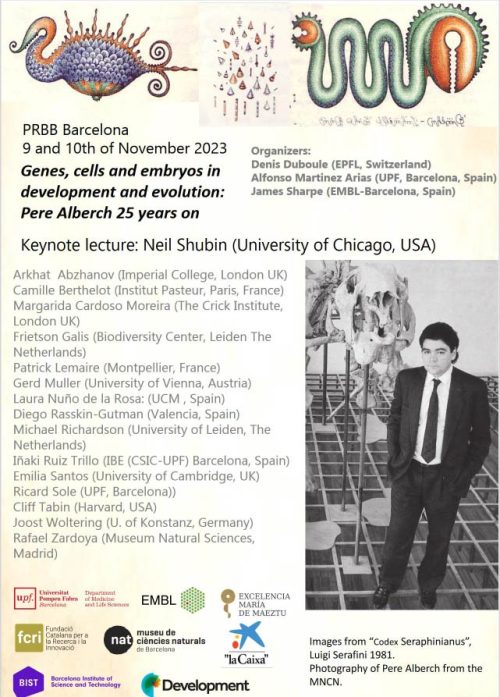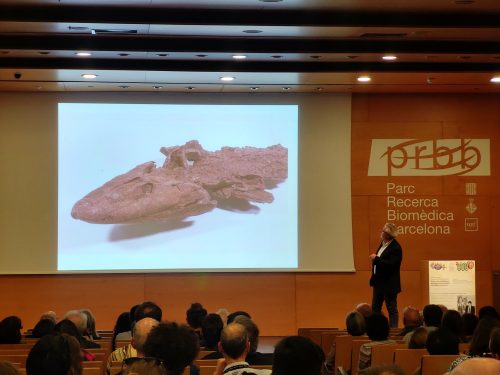Meeting report – “Genes, cells and embryos in development and evolution: Pere Alberch 25 years on”
Posted by Maria Costanzo, on 19 December 2023
I read the name of Pere Alberch for the first time while leafing through a collection of articles on Ecology and Evolution edited by the Universidad Autónoma de México [1]. At the time I was a bachelor’s student of Biology at the University of Turin, desperately collecting material for my final dissertation on the role of physical parameters in shaping form during embryo development. In the paper “Evolution and complexity: developmental constrains” by B. Luque & J. Bascompte, I found out that Pere was a “blighted theoretician of development and experimental embryologist” who did seminal work on the development and evolution of the tetrapod limb. Despite having only recently closed my textbooks of Developmental and Evolutionary Biology, I had no idea that Pere was one of the founding fathers of Evo-Devo, a field that aims to connect evolutionary novelty to developmental dynamics, i.e. “phylogeny” to “ontogeny” [2]. To my surprise, most of his work was indeed rarely cited and his name would have been certainly forgotten were it not for the visionary power of his ideas and the determination of his scientific disciples, who so tenaciously kept those ideas alive.
Almost ten years later, I have had the chance to follow a celebrative symposium on Pere’s work, set in Barcelona, just few kilometres from where he was born. “Genes, cells and embryos in development and evolution: Pere Alberch 25 years on” took place at Barcelona Biomedical Research Park (PRBB), on the 9th and 10th November 2023, organised by Alfonso Martinez-Arias (Universitat Pompeu Fabra), Denis Duboule (École Polytechnique Fédérale de Lausanne) and James Sharpe (EMBL Barcelona). As the title suggests, the symposium aimed to cover each of the biological scales which are relevant to the study of development and evolution of form (the genetic, cellular and tissue scale), whose tight integration at the embryo level had been so consistently emphasized by Pere. Here is the link to the event: https://eventum.upf.edu/94510/detail/genes-cells-and-embryos-in-development-and-evolution-pere-alberch-25-years-on.html.

Who other than Denis Duboule could kick off the first session, entitled “Constraints and the hourglass”? His talk highlighted how the range of morphologies in the early stages of vertebrate embryonic development, during the so-called “phylotypic stage”, is restricted already at the chromatin level, with the Hox timer being one of the main agents constraining the ‘neck’ of the hourglass model. The presence of phenotypic invariance, of which the “phylotypic stage” is an example, was what intrigued Pere the most, together with the study of abnormal phenotypes or “monsters” as a powerful tool to get a glimpse into otherwise hidden developmental rules [3]. The next speaker, Freiton Gallis (Leiden Biodiversity Center), built her research upon these two aspects, focusing on the conservation of the number of cervical vertebrae in mammals and on the analysis of vertebral defects such as cervical ribs. Arkhat Abzhanov (Imperial College London) illustrated his work on cranial shape variation in amniotes, followed by Michael Richardson (Leiden University) who fascinated the audience with a story of coevolution between a parasitic fish and the mussels that host its peculiarly-shaped eggs.
Patrick Lemaire (Centre de Recherche en Biologie Cellulaire de Montpellier) used the “parameter space” proposed by Pere in 1991 [4] to guide us through the world of ascidian embryos which display an incredible invariance in morphologies despite the extreme genetic divergence among species and their phenotypic diversity as adults. Margarita Cardoso Moreira (The Francis Crick Institute), whose recently established lab explores the evolution of sexual dimorphism, highlighted how sex differences can be traced down even to the cellular level! Her talk was followed by Camille Berthelot (Institut Pasteur), whose lab exploits organoid models of the uterine epithelium to study a trait that, similarly to sex differences, evolves quite rapidly: embryo implantation. The session, entitled “Of genes and cells”, was finally closed by the provocative talk of Iñaki Ruiz-Trillo (Universitat Pompeu Fabra) who clearly stated that we are still quite far from understanding what the unicellular ancestor of animals, the source of all the phenotypic diversity we witness at the present day, looked like. We left for lunch with a glimpse of hope that, through the use of metagenomics and the sampling of new taxa of unicellular organisms, we will be able to better address the origins of multicellularity.
The afternoon session was a journey in Pere’s life, fortune and friends. It started with the talk of Gerd Müller (University of Vienna), one of Pere’s closest collaborators. His presentation showcased some of his old work with Pere on the archosaur limb [5] together with some more recent work on polydactyly, and was interspersed with pictures of their fruitful meetings and forays. While the philosopher Laura Nuño de la Rosa (Universidad Complutense de Madrid) explained the reasons why Pere may have been forgotten by the scientific community over the years, despite his relevance for the Evo-Devo field, Diego Rasskin-Gutman (Universitat de València) clearly expressed why he cannot forget his mentor and how Pere’s ideas deeply influenced the work of his own lab, including the development of the Anatomical Network Analysis (AnNA) for topological analysis of organismal form. In the last years of his life, before his premature death in 1998, Pere became director of the Natural History Museum of Madrid. Rafael Zardoya, the current director of the museum, gave the last talk of the session, showing the crucial role that Pere played in restoring the Museum to its former glory and how deeply his decisions are still impacting the organization of the museum today.
Day 1 of the conference closed with a keynote lecture from Neil Shubin, who was one of Pere’s first PhD students at Harvard University. His engaging talk gripped the minds of the audience, who very much enjoyed the narration of the discovery of the Tiktaalik fossil, the first fish venturing onto land. He mostly focused on his work on fin-to-limb transition in vertebrates and hinted to some new work he is envisioning to do on salamander limbs, which relates to his PhD project in Pere’s lab.

Ricard Solé (Universitat Pompeu Fabra) kicked off Day 2 of the conference, arguing that the logic of life is predictable since life itself has its own constraints: in order for life to exist, even in another planet, certain conditions need to be met. We came back to earth for the rest of the session, in particular to life in the waters: Berta Verd (University of Oxford), Joost Woltering (University of Konstanz) and Emilia Santos (University of Cambridge) each illustrated their research on teleost fishes. Verd and Santos both exploit cichlid fishes as model organisms to study the evolution of two different morphological traits: vertebral counts and pigmentation patterns, respectively. Interestingly, cichlid fishes display a wide phenotypic diversity despite bearing similar genetics, falling on the opposite side of the spectrum with respect to ascidians. Joost Woltering uses a variety of teleost fish models in his lab to look at morphogenesis and evolution of their dermal skeleton, with particular attention to fins. With James Sharpe’s talk we shifted from fins to limbs, having the chance of listening to some new insights on digit pattern formation, an intriguing follow-up to some of Pere’s old work [6].
The task to close the conference was given to another speaker that has been deeply influenced by Pere’s work: Cliff Tabin. He surprised everyone by announcing that his talk would focus on the physical forces shaping gut development, rather than the topic of heterochronic shifts in limb development. As an homage to Pere, he showed how the circular model of morphogenesis Pere proposed in 1989 [3] can elegantly explain the process of villification in chick gut tube, a topic that the Tabin lab has been working on for over 15 years. Pere stated that genes undoubtedly influenced cell properties and thus morphogenesis by contributing to tissue geometry, but that tissue geometry and so the morphogenetic outcome (the ‘structure’ itself), feeds back into gene regulation, making morphogenesis a rather dynamic process and, far less simplistic than what was previously thought. This was my favourite talk of the conference, since it unleashed the true revolutionary power of Pere’s ideas and their relevance in the study of development and evolution.

As Laura Nuño de la Rosa explained on Day 1 of the conference, there are a number of reasons for the aura of mystery around Pere’s work, which despite his relevance for the field of Developmental and Evolutionary Biology is very poorly cited. These include the fact that Pere had to close his lab in Harvard for lack of funding, his rather quarrelsome personality that did not make him popular among collaborators, and his premature death in 1998. By the end of the meeting, I understood more clearly why I had only encountered his name in a hidden collection of papers rather than in the textbooks or classes where I had first about Evo-Devo in University. As Alfonso Martinez-Arias stated in his closing remarks, this symposium proved that, despite “the slings and arrows of fortune”, ideas can outlive their creators and do not fade despite their work being ignored by the scientific community. The circular view of causation in morphogenesis, development as a new level of selection between genotype and phenotype, the genotype-phenotype maps, the importance of ‘monsters’: all of this we owe to Pere and we can only thank him for promoting avenues of research that are so relevant today.
References to Pere’s work:
[1] Benítez M. et al., ‘Frontiers in Ecology, Evolution and Complexity’, Copit-arXives, Mexico DF 2014.
[2] Alberch et al., ‘Size and shape in ontogeny and phylogeny’, Paleobiology, 1979, 5(3):296-317.
[3] Alberch P., ‘The logic of monsters: evidence for internal constraint in development and evolution’, Geobios, 1989, 12:21–57.
[4] Alberch P, ‘From genes to phenotype: Dynamical systems and evolvability’, Genetica, 1991, 84: 5–11.
[5] Müller G. and Alberch P., ‘Ontogeny of the limb skeleton in Alligator mississippiensis. Developmental invariance and change in the evolution of archosaur limbs’, Journal of Morphology, 1990, 203: 151–164.
[6] Alberch P. et al, ‘Size dependence during the development of the amphibian foot: Colchicine-induced digital loss and reduction’, Journal of Embryology and Experimental Morphology, 1983, 76: 177–197.


 (2 votes)
(2 votes)